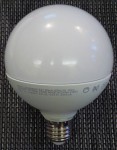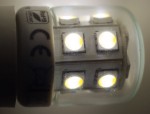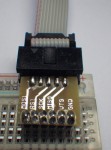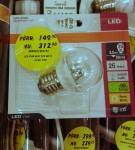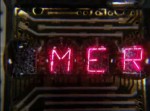Transatlantic recently asked about a new IKEA LED lamp, the LEDARE with 1000 lm. It comes as a quite big globe (diameter 95 mm) with an E27 socket, an electrical power rating of 16.5 W and is supposed to be dimable! Transatlantic commented on the high quality of the warm-white light output and wondered if… Continue reading That’s bright!
Category: Electronics
LED lamps are (not) forever
Two weeks ago I wrote about my experience with special price offers for LED bulbs at Bauhaus. What I didn’t write was that I then just went to the other side of the street – well almost – and bought a 2.2 W E14 LED bulb at Jula. Why – well I have six of… Continue reading LED lamps are (not) forever
AVR ISP breadboard adapter
Breadboards are great! I mean the solderless breadboard type which you can get everywhere now for almost no money. I use them all the time to prototype electronics circuits and have been forcing my students to do the same. Most of my current projects also involve AVR microcontrollers which support an in-system programming. For this… Continue reading AVR ISP breadboard adapter
special offer at Bauhaus
Today I was at Bauhaus in Uppsala, just browsing, not looking for anything special. Close to the exit there was a table with LED light bulbs which were obviously taken out of the regular assortment and re-labelled with new prices. Usually you would expect a bargain – and since I am somewhat sold to LED… Continue reading special offer at Bauhaus
Do you need a byte?
My latest Instructable is on the design of a breakout board to view the state of up to eight bits in a breadboard circuit. I don’t fell I have the time to repeat all the steps from the Instructable here, just let me tell you that it works nicely! The circuit itself is simple: the… Continue reading Do you need a byte?
Merry Christmas!
MOSFETs – what the datasheet doesn’t tell you
I am planning to construct a logarithmic current meter and were yesterday doing some simulations with LTspice. Using a logarithmic converter you can span a wide range of currents with a single readout without the necessity to switch ranges. Of course this has disadvantages as well, but if you know what you are doing it… Continue reading MOSFETs – what the datasheet doesn’t tell you
Repairing a Samsung Syncmaster 913TM
I recently got hold of another broken Samsung monitor. This time it is a Syncmaster 913TM which is characterized by its swiveling stand, which allows the screen to be rotated by 90 degrees. I would not call this “portrait” as opposed to landscape, because of the screen’s almost square aspect ratio of 5:4. Connecting power… Continue reading Repairing a Samsung Syncmaster 913TM
Notes from the student lab
Every place in our course laboratory is equipped with an analog oscillsocpe and a Metex Universal System. This instrument consists of a power supply with two fixed and a variable outpur voltage, a multimeter, a function generator and a frequency counter. This sounds nice and it usually is – most of the time the instrument… Continue reading Notes from the student lab
About filters and cut-off frequencies
A good question was brought up by my students in the lab exercise in the course Electronics I yesterday: What actually makes the cut-off frequency of a filter circuit (1st order) so special? Why do we look out for a point which happens to be located or a factor of under the amplitude of the… Continue reading About filters and cut-off frequencies

